With Yandex being the most widely used search engine in Russia, it may be an essential part of your SEO strategy.
Yandex has closed the gap on Google over the past couple of years due to legal rulings against Google by Russia’s anti-monopoly departments, resulting in changes to the default search engine on Android devices.
More than just a search engine, Yandex also provides a browser (YaBrowser), email, news, maps, paid advertising, and translator services to the Russian market, as well as in Belarus, Kazakhstan, Ukraine, and Turkey.
In this guide, you’ll learn everything you need to know about the following from a Yandex-specific perspective:
- Technical SEO
- Image SEO
- On-Page SEO
- Off-Page SEO
- Local SEO
- Mobile SEO
- International SEO
- Keyword Research Tools
Yandex Technical SEO
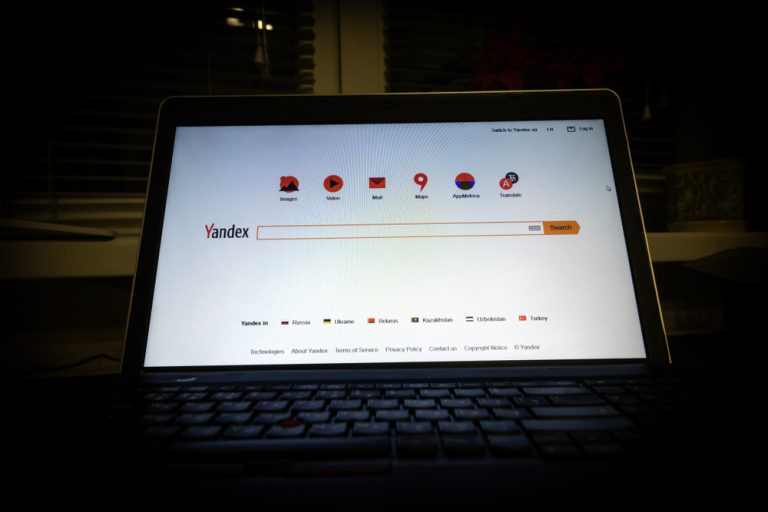 Yandex offers a number of free services, similar to Google
Yandex offers a number of free services, similar to GoogleWhile there are a number of similarities between Google and Yandex, the Russian engine has its own set of rules and nuances that need to be taken into consideration when designing and developing your Russian website (or alternate version).
| Element | Importance |
| Header Tag | Very Important |
| Title Tag | Very Important |
| Meta Keyword Tag | Important |
| Keywords in URLs | Very Important |
| Internal Linking Structure | Somewhat Important |
Getting Indexed in Yandex
Google spoiled us with its Caffeine update and how quickly it discovers and indexes fresh content.
Yandex, however, takes a little longer to discover new sites and URLs.
To get content indexed more efficiently within Yandex, it’s important to submit sitemaps via Yandex.Webmaster.
JavaScript & CSS
In November 2015, Yandex reported via its webmaster blog that it had started to crawl JavaScript and CSS. A later support article covered how Yandex treats AJAX websites.
In short, Irstlena Pershina, an active Yandex public spokesperson on their webmaster blog, recommended the below in 2018, in response to a question about Angular, AngularDart, and whether they need server-side rendering:
A general rule: there must be static content for the robot. Irstlena Pershina, May 7 2018, 18:18hrs
In the first quarter of 2021, some webmasters reported that Yandex had indexed their SPA, but this was hotly debated in the same forums that these reports appeared and, with the information available, dismissed by the wider community.
Hreflang & XML Sitemaps
For a long time, Yandex only supported the <head> hreflang implementation. However, in August 2020, they updated their support documentation to include XML sitemap hreflang support.
Page-Level Tags
Unlike Google, Yandex does support the meta keywords tag as an HTML element:
<meta name="Keywords" content="..."/>– May be used when determining the page’s relevance to search queries.
Cloaking
In 2008, Yandex introduced an algorithm with the codename Nakhodka with the aim of preventing and identifying cloaking in a much more aggressive manner. Based on numerous blog posts, this appears to have worked.
Intrusive Pop-Ups
In 2012, Yandex updated its core algorithm to tackle websites with intrusive (and fake notification) pop-up windows.
This was later updated in 2014 to be even stricter on pop-ups that interfered with user experience and content accessibility.
On-page SEO for Yandex
Yandex has a number of algorithms that ensure users are met with quality, useful content matching their search intent.
This process began in 2007 through an unnamed update that introduced new ranking and variable weightings for single and multi-word search queries.
8-SP1
The unnamed update was followed in 2008 by the first officially named algorithm, the catchy 8-SPI1.
During this time in Yandex’s history, older websites ranked higher because of their age. This algorithm worked to change that, giving fresher (and potentially better quality domains) more of a fighting chance to rank for top positions.
This algorithm also changed how backlinks were weighted as a ranking factor, in the sense that it lessened their power.
8-SP1 was followed by some smaller quality algorithm changes, namely Magadan (2008) which enabled the search engine to understand abbreviations, as well as start to understand the difference between commercial and non-commercial queries and content uniqueness.
AGS Filter
The AGS filter was first introduced in September 2008 and was updated in 2009, 2013, 2014, and 2015. You could refer to this as Yandex’s Panda algorithm.
The first iteration of the algorithm was primarily concerned with duplicate and low-quality content.
Later updates meant Yandex could demote the rankings of websites built to drive traffic for on-page ad impressions, and penalize websites focused on selling and placing links.
Reykjavik & Kaliningrad
Reykjavik (2011) and Kaliningrad (2012) were the first steps in Yandex search personalization. Search history, cookies, and user behaviors began to influence and create personalized search results.
Yandex ICS
The Yandex ICS score replaced their longstanding TIC (Thematic Index Citation) and replaced it with the more modern ICS score.
ICS is a site quality score used to determine how relevant a website is in relation to a query.
The main data points taken into account when calculating this score are:
- Yandex’s estimated audience of the brand/website (bigger reach and brand search is better).
- How well Yandex perceives the website to satisfy user queries, taking into account factors such as site popularity, time to result (TTR), and other user metrics.
- Yandex’s own interpretation of E-A-T.
- Whether or not the website has any of the 16 site quality marks.
This differs from the TIC score, in which backlinks were one of the key data points used to determine suitability.
Yandex Image SEO
Optimizing images for Yandex isn’t too dissimilar from the same practices you would utilize for Google.
However, there are some differences that can help give you an advantage when it comes to how highly Yandex returns (or ranks) your images within search results.
Yandex acknowledges that images can help improve the user experience and quality of a webpage. Well-optimized images can help improve a webpage’s individual ranking in search results through improved behavioral factors (ICS score) and generally improving the page’s relevancy for that specific query.
It’s important to note that Yandex.Search and Yandex.Images are two separate entities.
Each uses a unique algorithm to determine content ranking. It’s possible for your webpage to be indexed in normal search results, but the image excluded from image results.
How Yandex Indexes Images
When it comes to indexing images, Yandex’s user-agent downloads them from links making use of either the img or src attribute.
Yandex also supports data-src and data-original, and at present only indexes images in JPEG, PNG, or GIF format.
Yandex will only index images that are not blocked directly by the robots.txt file, or located only on pages that themselves are blocked.
Aside from these technical prerequisites, Yandex also determines an image’s value and whether or not it is worth indexing based on the image description and associated metadata. This is also one of a number of ranking factors for Yandex image search.
You can also upload an image XML sitemap to your site and specify a number of information points including the image caption, the location where it was shot, its title, and a link to the image license URL.
The image XML sitemap can be especially useful if your website typically serves image content through JavaScript, as Yandex does currently have issues with identifying content and links served by this method.
Ranking Images In Yandex
In Yandex’s documentation, they describe image metadata as being one of a number of ranking factors taking into account by the search engine.
The types of image metadata important to Yandex are:
- The text included within the image alt attribute.
- The text included in the image title attribute.
- The name of the image file itself.
These factors alone can enable an image to rank for a query related to the image itself, even if it’s not present as plain text on the page wherein the image is located.
The alt and title attributes are the most universal, and Yandex recommends that they are always specified.
This being said, the text and focus of the page itself can also impact how well an image performs in organic search.
For shorter articles and texts, headers on the page can also play a role. But for the most part, Yandex takes into account the text in and around the image proximity.
When it comes to writing image captions, titles, and descriptions, Yandex recommends that they are written with the user in mind. Make them as informative as possible; this is not an opportunity to keyword-stuff.
Image Schema
Yandex supports schema mark-up for images. In their webmaster documentation, they claim that by using this type of schema mark-up you can improve your website footprint in the Yandex.Images search results.
Yandex provides support for schema mark-up implemented in Microdata format (unlike Google, which prefers JSON-LD), and supports the below itemprops:
- Content Url or image (required).
- Thumbnail.
- Name.
- Caption.
- Description.
- Height.
- Width
Yandex Local SEO
Because of the sheer size of Russia, localized search works slightly differently than what we’re used to with Google — even in similarly large countries such as the United States.
Within Yandex.Webmaster, you’re able to specify the region that you’re targeting (if applicable). From a user perspective, geotargeting searches are an important part of getting useful and relevant results.
Arzamas & Konakovo
In 2006, the Arzamas update allowed users to manually determine if they saw national or regional search results. The 2009 Konakovo update saw this rolled out to more than 1,250 cities in countries including Ukraine, Belarus, and Kazakhstan.
Yandex checks your website’s IP, contact information (make sure this is structured and displayed clearly), and domain registration information.
If all signals here point to the Nenets Autonomous Okrug region but you’re actually targeting the Murmansk Oblast region, you might not rank as highly in local searches.
This functionality was improved further in 2010 through the Obninsk algorithm, which also saw websites boosting local rankings with spam directory listings penalized.
Changing Your Yandex Region
As mentioned, you can set your region in your Yandex.Webmaster account. However, this is only a request and isn’t taken as gospel by the search engine.
If you’re not targeting a specific region (e.g., you’re an online retailer that can ship to anywhere), you won’t be affected by Yandex’s localized search for online retail queries.
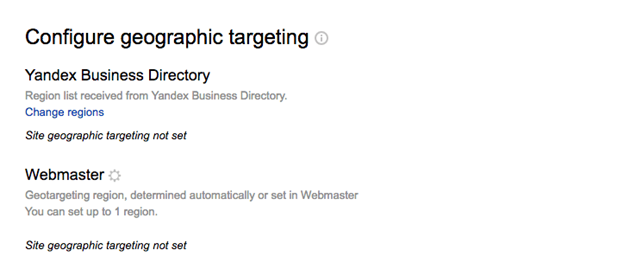
You can specify up to seven regions within Yandex.Webmaster, but in order to do so you must be listed in the Yandex.Catalogue.
Yandex Offsite SEO
While Google’s Penguin algorithm didn’t become part of our lives until 2012, Yandex introduced their first link-based algorithm in 2005. It had no official name but became known as the Nepot filter. It aimed to reduce the impact of link exchanges, PBNs, and other spam links.
In addition to link quality, the Nepot filter specifically looked for unnatural link acquisition patterns. Unofficially, this appeared to have been updated again in 2008.
Ranking Without Links
In 2013, a beta algorithm was rolled out in Moscow for some verticals (namely travel, real estate, and household appliances), and it produced rankings without taking links into account.
Very little information exists about how successful the trial was. But in 2015, a new link-based algorithm named Minusinsk launched. From that, we can infer that the “no links” rankings didn’t work out too well.
After the Minusinsk announcement, webmasters who had engaged in link spam tactics received notifications through Yandex.Webmaster, and the algorithm rollout saw three key impact dates:
- May 15.
- May 27.
- June 23.
Yandex Mobile SEO
It’s estimated that there are 80 million smartphone users in Russia. If current growth continues, this will reach 93 million in 2021.
The mobile search market in Russia is also going through a turbulent time of change.
In May 2017, the Russian Antimonopoly Service ruled that Google’s default Android OS was too restrictive and not in the best interest of the consumer. Google was forced to develop a widget and new Android OS to make it easy for users to change default their search engine.
Given that the most recent data shows that Android holds around 70% of the market, this has led to a huge swing in mobile search engine market share. Yandex’s share grew from 29% to 44% in the space of a year, at the expense of Google.
Whilst Yandex has made gains, Google managed to stall Yandex’s growth and remain in control as the dominant search engine — but only on a 51% to 36% margin.
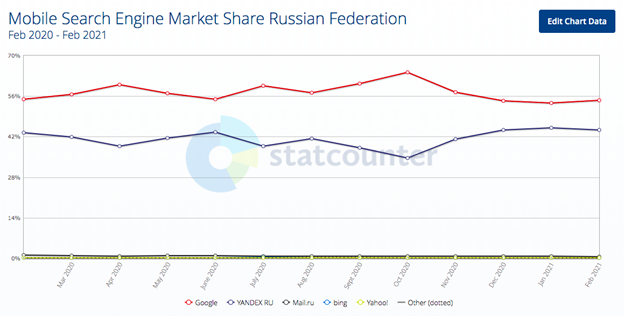
Vladivostok Algorithm
Yandex introduced an algorithm change with the codename Vladivostok, and this was aimed at providing a better experience for mobile users.
Historically (since November 2015), Yandex had tagged mobile-friendly websites within search results (which was roughly 18% of sites at the time).
This was really the first “push” to make webmasters think about mobile experiences and start to plan responsive, dynamic, or m-dot websites.
Vladivostok allowed a slight grace period for websites not yet providing good mobile experiences for users, but they did see some fluctuations and a gradual decline.
One interesting takeaway from Yandex’s mobile ranking factors (which aren’t too dissimilar to mobile ranking factors we’re used to with Google – and providing great user experiences) is that in Yandex’s mobile-friendly checker, there is a criterion for mobile-friendly text size.
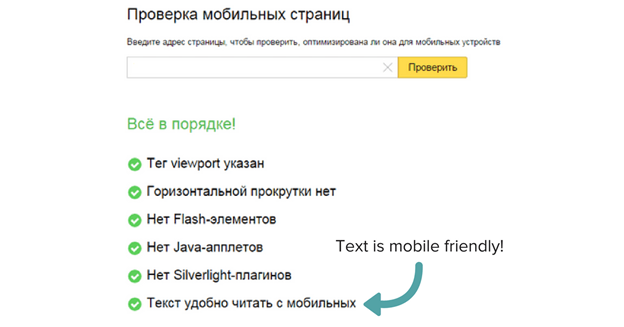
If the font is 12px or more, it is considered mobile-friendly. If the page has a smaller font size, it will be impacted negatively within search engine results pages.
Yandex International SEO
In 2020, Yandex updated its Webmaster support documentation. We learned that the search engine now supports Hreflang implementations through the XML sitemap, whereas previously they only supported implementation via the HTML <head> code.
Similar to Google, Yandex also advises against using GEO-IP redirects to force users to the correct site version.
Yandex Keyword Research Tools
Keyword research, a staple of any SEO campaign, is just as important as ever.
A number of accessible tools make it easier to conduct in-depth keyword research in the Russian market.
Yandex Wordstat
Wordstat is one of my favorite tools for conducting keyword research in Russia. It’s a part of Yandex’s paid search toolkit and allows you to break down searches by region.
From experience, I also tend to trust the impression data here a lot more than that of the second tool in this section.
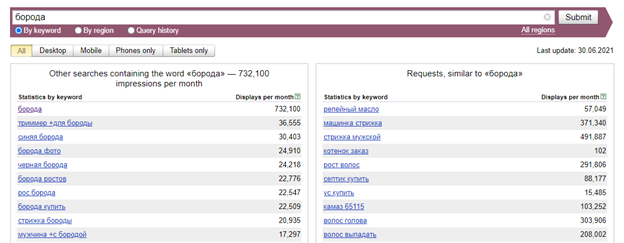
Google Keyword Planner
Given that Google is the second largest search engine in Russia (when device statistics are blended), the AdWords Keyword Planner tool works for the Russian market.
It also gives more broad and extensive lists of related keywords, although relevancy sometimes suffers so the long list can require a lot of pruning back.
The search volumes provided are also, from experience, less accurate than Wordstat’s.
Mail.ru Keyword Tool
Mail.ru is the third-largest search engine in Russia with approximately 8% of the market. But while the search engine itself isn’t popular, its webmaster tools provide data on user behavioral factors as well as breaking down keywords by user age and gender.
Combining the data from these tools with other suite staples such as SEMrush can help create more comprehensive keyword research lists.
Ahrefs
Ahrefs has improved its Yandex (and Russian language) database within its Keyword Explorer tool, which is great given that it may already be a part of your tool suite.
Whilst Wordstat can be more accurate for search volume data, Ahrefs can be used in conjunction for further keyword discovery.
Bonus: Yandex Search Operators
Search operators such as site: and inurl: can be invaluable to SEO professionals when diagnosing index issues.
Yandex also has a number of operators that differ slightly from those of Google. Good ones to keep on hand are:
- Title[keyword] – Search for a given keyword within a title tag, works the same way as Google’s intitle:
- Inurl=”keyword” – Works the same way as Google’s inurl:
- Mime=”html/pdf/doc/ppt/xls/rtf/swf” – Searches for specific file types, for example: seo << mime=”ppt” would return results that are PowerPoint files related to SEO.
You can structure keywords into most operators and their variables in the below format:
Keyword << [Operator]=”variable”
And that’s everything you need to know about Yandex SEO! Be sure to read the linked resources throughout this guide and keep it on hand for quick reference.
More Resources:
- 9 Frequently Asked Questions About Yandex SEO & PPC, Answered
- 17 Great Search Engines You Can Use Instead of Google
- How to Do Keyword Research for SEO: The Ultimate Guide
Image Credits
All screenshots taken by author, July 2021





